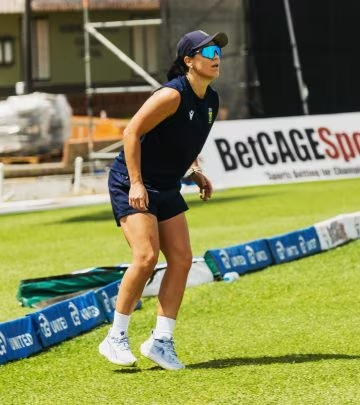Maximizing Pogo Effect: Spring-Mass Model In Fast Bowling
Cutting-edge force metrics empower elite cricket players to surge into new realms of speed
Image: Instagram
In high-speed sports like fast bowling, every millisecond counts. Emerging training insights now stress that ground contact time is the heartbeat of effective movement. As elite cricket players sharpen their skills, understanding the spring-mass model and mass-specific force is proving to be a game changer.
Understanding The Spring-mass Model
A recent discussion by cricket performance experts explains that when it comes to explosive movement, it’s not just muscle strength that matters. The secret lies in the rapid storage and release of elastic energy in tendons such as the Achilles, plantar fascia, and the calves. This system is akin to a pogo stick—stiff on landing and elastic in rebound. In fast bowling, this means minimizing the time the foot is in contact with the ground while maximizing the force generated per unit time.
The concept is straightforward: the human body can be seen as a spring. With every stride, the body compresses and recoils, much like a spring loaded with energy. The goal for athletes is to achieve a short ground contact time, high vertical force output, minimal center of mass drop, and a quick, stiff rebound. These factors are measured in terms of mass-specific force—the vertical force produced per kilogram of body weight. According to performance analysis, the higher this number is, the more efficiently an athlete can rebound off the ground, boosting speed and overall performance.
Mass-specific Force In Action
The analysis makes it clear that in sports such as fast bowling, every fraction of a second is vital. The force athletes produce isn’t merely about how much strength they have; it’s about how effectively they can use that strength relative to their body mass. The detailed breakdown in the discussion highlights that these mechanics are not muscle-dominant but tendon-driven. That means that training should focus on the rapid storage and release of elastic energy rather than simply building muscle mass.
The principles discussed include several key performance indicators:
• Short ground contact times
• High vertical force outputs
• Minimal center of mass drop during stance
• Quick, stiff rebound similar to a compressed spring
Such detailed insights come at a time when innovative training methods are re-defining how fast bowlers prepare for competitive scenarios. Not just run-up speed, but the preservation of kinetic chain energy during delivery is being scrutinized. This scientific approach, often described as the ‘pogo effect’, is critical for reducing braking forces and maximizing stride frequency, ultimately improving running economy.
Training The Pogo Effect
Steffan Jones, whose expertise in cricket performance is well recognized, is among those championing these advanced methods. In collaboration with experts at PaceLab, Jones emphasizes that the focus should be on training the spring—perfecting that quick, reactive bounce—rather than simply stomping through drills. His approach, backed by decades of experience, aligns with his insistence on measuring critical metrics like ball speed and mass-specific force on a weekly basis. This is not merely about accumulating repetitions, but about ensuring that every session contributes to performance improvements.
Recent Instagram updates by PaceLab provide further context. One post underscores the importance of validating fast bowling techniques through weekly measurement, ensuring that the training methods are transferring effectively. These updates reinforce the idea that consistent monitoring of ball speed and rebound dynamics helps detect performance drop-offs before they become critical.
In another detailed Instagram update, PaceLab stresses that intensity should drive adaptation, not volume. The focus on precision and intent in every drill is seen as essential for achieving that ideal spring-mass behavior. A measured, data-driven approach is being promoted, where every fast bowler is encouraged to adapt their technique responsively over time. When athletes experience improvements in their ground contact patterns, their run-ups—although instinctively consistent—begin to adjust naturally to meet the demands of competitive cricket.
Adapting To Competitive Demands
Training protocols based on the spring-mass model are not designed to overhaul a bowler’s technique overnight. Instead, they provide a framework for incremental improvements. With credentials built over 20 years of performance reporting, Steffan Jones has noted that incorporating these biomechanics into regular training sessions can lead to major leaps in performance. His contributions help demystify the process by linking the scientific principles of movement to practical, on-field benefits. When bowlers optimize their lower-limb mechanics, they not only enhance speed but also reduce injury risks by aligning force production with natural body movements.
This refined training ideology, presented by PaceLab in collaboration with leading experts, invites fast bowlers into an exclusive membership community. The idea is to share detailed insights and data-driven methods that have never before been introduced in cricket. The focus is on building a training ecosystem that emphasizes informed technique adjustments, careful load management, and the constant quest to balance energy output with injury prevention.
Through discussions on platforms like Instagram, content creators and performance trainers alike are urging bowlers to “train the spring, not the stomp.” This mantra encapsulates the new approach where the athlete’s response is fine-tuned to perform like a perfectly calibrated spring, leading to elevated performance without added strain.
In the dynamic world of cricket coaching and performance, these insights from Steffan Jones and his collaborators signal a shift towards scientifically informed practices. Fast bowlers are now not only required to exhibit raw power but also to harness their body’s biomechanical efficiency. With every stride and every ball delivered, the integration of mass-specific force metrics and spring-mass theory is transforming training into a more precise and adaptive science.
As the cricket arena evolves, the blend of science and practice continues to drive the next generation of fast bowlers. This approach is set to redefine performance benchmarks—demonstrating that understanding the mechanics behind the move can be just as important as the move itself.
Read full bio of Joyce























